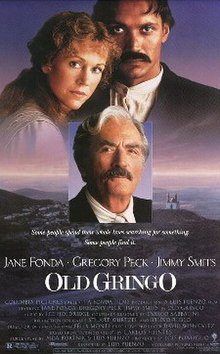Old Gringo
| Old Gringo | |
|---|---|
 Theatrical Poster | |
| Directed by | Luis Puenzo |
| Screenplay by | Aída Bortnik Luis Puenzo |
| Story by | Carlos Fuentes |
| Produced by | Lois Bonfiglio |
| Starring | Jane Fonda Gregory Peck Jimmy Smits |
| Cinematography | Félix Monti |
| Edited by | William M. Anderson Glenn Farr Juan Carlos Macías |
| Music by | Lee Holdridge |
| Distributed by | Columbia Pictures |
Release date | October 6, 1989 |
Running time | 119 minutes |
| Country | United States |
| Language | English |
| Budget | $27 million |
| Box office | $3,574,256 |
Old Gringo is a 1989 film directed by Luis Puenzo and co-written with Aída Bortnik, based on the novel Gringo Viejo by Mexican novelist Carlos Fuentes.[1]
The film stars Jane Fonda, Gregory Peck, and Jimmy Smits.
The film was screened out of competition at the 1989 Cannes Film Festival.[2]
Plot
American schoolteacher Harriet Winslow (Jane Fonda) goes to Mexico to work as a governess for the Miranda family, and becomes caught up in the Mexican revolution. Mexicans transporting her from Chihuahua, secretly soldiers of Pancho Villa's army, use her luggage to smuggle weapons to the servants at the Miranda hacienda. The servants in turn aid the attacking revolutionary army of General Tomas Arroyo (Jimmy Smits). During the attack, a sardonic "Old Gringo", American author Ambrose Bierce (Gregory Peck), joins the fighting on the side of the revolutionaries; he operates a railway switch that sends a railroad flatcar laden with explosives to its target.
After the Miranda hacienda is taken, Winslow becomes romantically attracted alternately to Bierce and then Arroyo. Bierce has come to Mexico to die in anonymity; he feels that his fifty years as a writer have won him praise only for his style, not for the truth that he's tried to tell. Arroyo, by contrast, has returned to the hacienda where he was born. His father was a Miranda who had raped his peasant mother. Later in his youth, Arroyo murdered his father.
While his army enjoys previously unknown luxuries on the war-damaged palatial estate, Arroyo becomes obsessed with his past. Transfixed by childhood memories of his family buried there, he fails to move his army when ordered by Villa. To bring Arroyo to his senses and avert a mutiny of his officers, Bierce burns papers that the illiterate Arroyo considers sacred—papers that supposedly entitle the peasants to the hacienda land. Arroyo responds by shooting Bierce in the back, killing him. Bierce dies in Winslow's arms.
Winslow goes to the U.S. embassy in Mexico to claim Bierce's body and bring it back to the United States. She claims that he was her long-lost father. This puts Villa in a predicament because a U.S. citizen was murdered by one of his generals. Wishing to avoid American meddling in the revolution, he has Winslow sign a statement that her father had joined the revolution and was executed for disobeying orders, as was General Arroyo who had shot him, and that she witnessed both executions. She signs the statement, is provided with the coffin bearing Bierce's body, and witnesses the execution of Arroyo.
Cast
- Jane Fonda as Harriet Winslow
- Gregory Peck as Ambrose Bierce
- Jimmy Smits as Gen. Tomas Arroyo
- Patricio Contreras as Col. Frutos Garcia
- Jenny Gago as La Garduna
- Gabriela Roel as La Luna
- Sergio Calderón as Zacarias
- Guillermo Ríos as Monsalvo
- Jim Metzler as Ron
- Samuel Valadez De La Torre as Consul Saunders
- Anne Pitoniak as Mrs. Winslow
- Pedro Armendáriz Jr. as Pancho Villa
- Pedro Damián as Capt. Ovando
Reception
The film received mixed to negative reviews, with a 42% "Freshness" rating at the review aggregator site Rotten Tomatoes.[3] It was a box-office failure.[4] Jane Fonda received a Razzie Award nomination for Worst Actress for her performance in the film, where she ended up losing to Heather Locklear for The Return of Swamp Thing.
References
- ^ Old Gringo at the Internet Movie Database.
- ^ "Festival de Cannes: Old Gringo". festival-cannes.com. Retrieved 2009-08-04.
- ^ "Old Gringo". Rotten Tomatoes. Retrieved May 17, 2012.
- ^ James M. Welsh (January 2000). "The Old Gringo". Masterplots II: American Fiction Series. Retrieved 18 May 2012.
